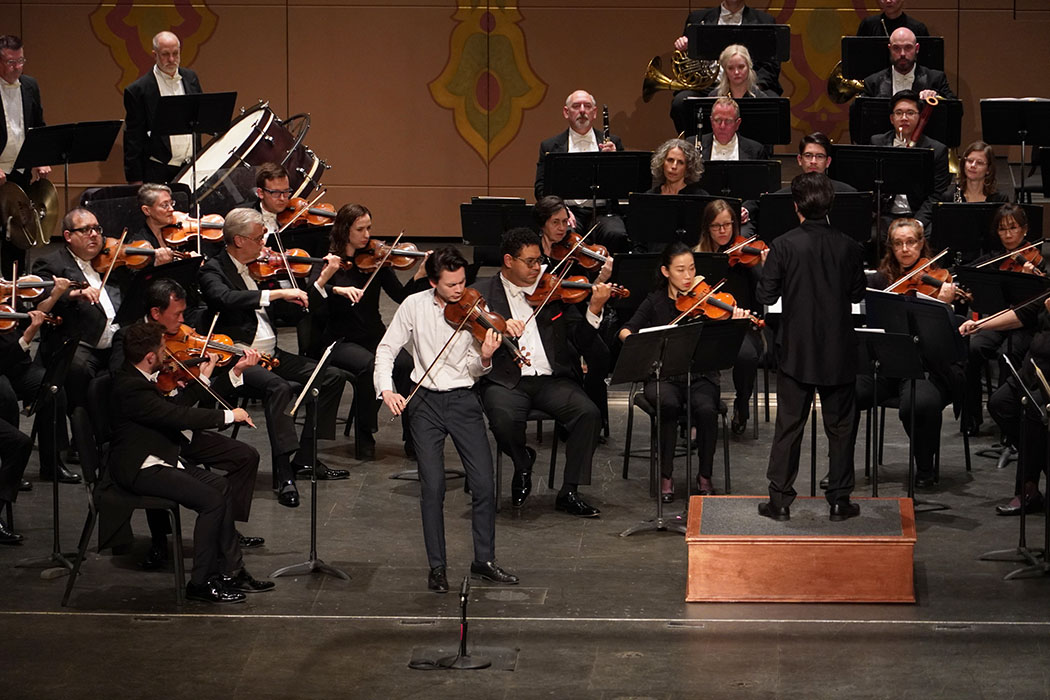Concerts have an intriguing way of taking on a life and meaning of their own. That meaning may be obvious and intentional, or personal and ineffable. That is the joy—and burden—of those that program concerts: the realization that any grouping of works can affect an audience’s perception and reception of each.
In the case of this weekend’s impressively performed Knoxville Symphony Orchestra concerts that featured Anna Clyne’s PIVOT, Bruch’s Scottish Fantasy, and Beethoven’s “Pastoral” Symphony, I didn’t need a roadmap. In our pre-season Q&A, Maestro Aram Demirjian had revealed that having the virtuoso violinist Stefan Jackiw as soloist in the Bruch—a piece he regularly performs—set the stage for the program. A natural companion would be PIVOT, Clyne’s 2021 work that was inspired by her experience of attending the Edinburgh International Festival and the simultaneous distractions of the Edinburgh Fringe Festival.
But what for the second half of the concert?
“I thought about Mendelssohn’s 3rd Symphony [the “Scottish”] for the second half,” Demirjian explained, “but ultimately, I selected the Beethoven “Pastoral” based on one criterion: I listened to the Bruch and thought, “what does my ear want to hear next?” The opening bars of Beethoven 6 rang in my head immediately after, and we had our program.”
And what a program it turned out to be this weekend. Clyne’s exuberant PIVOT was an explosion of competing sonic forces that makes references to traditional Scottish folk tunes, but doesn’t shy away from suggesting the Scottish ancestors of American fiddle music. Demirjian and the orchestra embraced the luscious, often cacophonous smushing of styles and rhythms that alternated with glee between tradition and the avant-garde.

Let’s be honest. Violinist Stefan Jackiw is in a category of world class artists that, for budget reasons, we are rarely able to hear live in Knoxville concert halls. While his amazingly focused sound is crystalline, brilliant, and satisfying, he shapes passages with interpretative elegance and nuance. On a microscopic level, individual notes bloomed with dynamic surprises that ran the gamut from unbelievably soft to fiery, buttered with just the right amount of vibrato; trills seemed to have dimension, while in the big picture, his narrative style was a masterpiece of musical storytelling that embraced Scottish folk tunes and Bruch’s Germanic underpinning.
Although Bruch called his work a Fantasy, it is a violin concerto by any reckoning. The work’s full title, though, is “Fantasia for Violin with Orchestra and Harp, with the Free Use of Scottish Melodies.” Yes, there is a substantial part for harp and it was a pleasure to hear the KSO’s Principal Harp Cindy Emory in what amounts to a duet of sorts in the final movement.
On Friday evening, Jackiw was coaxed into an encore, a gorgeously nuanced Largo from Bach’s Unaccompanied Violin Sonata in C, BWV 1005.
Despite the recent Beethoven 250 celebration, it has been some years since the KSO performed Beethoven’s Symphony No. 6 (“Pastoral”). That being the case, it arrived with Demirjian (conducting without a score) and the KSO at the Tennessee Theatre like a breath of fresh, country air. As is often mentioned, the first movement begins almost informally—perhaps even cinematically—as if one has just come within hearing range of the orchestra. It is this flavor that carries the piece along, notwithstanding the “Thunderstorm” of movement IV.
Of course, just because the composer’s topic is one of serene country life of happy villagers and the randomness of nature doesn’t mean that the score is simple. In fact, Beethoven is at his most clever best in using instrumental interjections and fun, rhythmic figures instead of complex melodies or harmonies. As an example of those interjections in the third movement, “Merry Gathering of Country Folk,” the bassoon has a repeating downward motif that is subsequently bandied about by other woodwinds. Of course, the previous movement has the notable combination of woodwinds that become the birdcalls of nightingale, quail, and cuckoo. Kudos to the KSO woodwinds: Devan Jaquez, Principal flute; Claire Chenette, Principal oboe; Gary Sperl, Principal clarinet; Ryan Yamashiro, Principal bassoon; and Jeffery Whaley, Principal horn.
“Thunderstorm” was appropriately atmospheric both in the intense depiction of the thunder and lightning of a summer storm, but also in the falling rain made physical by the orchestra. The final movement, “Shepherds song. Happy, thankful after the storm” was a beautiful example, among many, of the KSO strings having developed a velvety, brightly-textured sound that is at home in both foundation and melodic narration. Kudos to the string principals here: William Shaub, concertmaster; Edward Pulgar, Principle second violin; Kathryn Gawne, Principal viola; Andy Bryenton, Principal cello; and Steve Benne, Principal bass.
And, it all comes together in the final bars with Demirjian and the orchestra finding an ending that is something of a symbolic mirror to the beginning: ebullient, happy, and with the glow of accomplishment.








